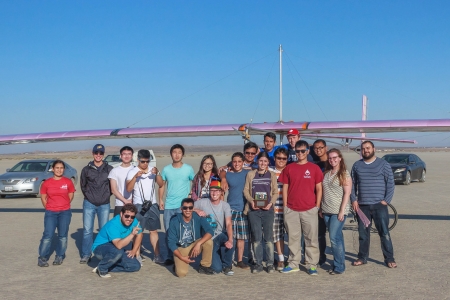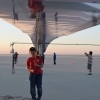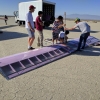 Sept. 28, 2016 - To catch the stillness of the Mohave Desert at sunrise, the Samueli School’s human-powered airplane (HPA) team pulled one heck of an all-nighter. Early morning, with its lack of wind, presented the best conditions for test flying their light aircraft, so the group of 19 students and alumni, who had all worked on the project at one time or another, drove to the El Mirage dry lake bed on Friday night, Aug. 5, and began assembling their prototype around midnight.
Sept. 28, 2016 - To catch the stillness of the Mohave Desert at sunrise, the Samueli School’s human-powered airplane (HPA) team pulled one heck of an all-nighter. Early morning, with its lack of wind, presented the best conditions for test flying their light aircraft, so the group of 19 students and alumni, who had all worked on the project at one time or another, drove to the El Mirage dry lake bed on Friday night, Aug. 5, and began assembling their prototype around midnight.
The plane is designed to be human powered using pedaling to drive the propeller. The purpose of the first flight testing was to validate the rest of the design and fabrication, before deeming it human ready. Thus the airplane was converted to a remote-controlled, battery-powered prototype.
After five years in development, the plane had gone through many modifications, as well as two project managers and three chief engineers. But its design always centered around a fully cantilevered wing with a span of 108 feet (six feet shy of a 737’s wingspan).
The engineers began the test flights at 7 a.m., Aug. 6. It took four tries and lots of on-the-spot trouble shooting and problem solving, but the aircraft actually lifted off the ground almost 10 feet and flew about 200 feet.
“We started this project with no experience regarding HPAs and had to learn on the spot while completing our undergraduate degrees,” said Jacqueline Thomas (’14), who revived the project at UCI in 2011 after a hiatus of 20 years. A licensed pilot, she served as the team’s first project manager and is now pursuing a graduate degree in aerospace engineering at MIT. “The HPA underwent many design changes the more we learned and as various students graduated. Transferring the knowledge of the design across various leaders proved a challenge and also critical to the HPA's success.”
Colin Sledge, graduate student adviser, manned the remote controls of the aircraft during the test. “On our very first test flight, we saw that the wing was drooping toward the ground. It wasn’t stiff enough. We stopped immediately.”
The team added trim tabs to the wing tips, which helped somewhat. On the second attempt, they realized if they could get the plane at a steep enough angle, the wing would untwist, but then the tail, which was symmetrical, dragged on the ground. Chief engineer Joseph Hsieh (’16) got out the hacksaw.
“We needed to pitch the airplane up at more of an angle than we had predicted, so we had to cut a foot off the tail,” Hsieh said. “That’s what ended up making the difference.”
“I could see after a couple bumps that the wing straightened out. It was the fourth attempt, when the plane did a small hop, that it caught air,” said Sledge.
“The HPA project presented a major design and fabrication challenge and required a high degree of dedication and teamwork,” said Professor Ken Mease, HPA faculty adviser. “It served to motivate and educate 150 students over five years. Seeing the remote-controlled, battery-powered version lifting off the ground in August was a tremendous and highly satisfying achievement for all involved.”
“I think we accomplished what we wanted to achieve,” said Hsieh who is staying on at UCI to earn a graduate degree in dynamics, controls and robotics. “When I stepped in, the question was, can we get this wing to work, to fly. There were issues in the stiffness of the wing. We tried to make an open air wind tunnel around it. We wanted to get it up in the air and see how it would behave, and we did.”
They also discovered that the plane was hard to control laterally. The pilot could pitch the nose up or down, but lost control when turning. On the fourth attempt, the fuselage was damaged.
Hsieh used the test flight information to run a few calculations and determined that, with the current configuration, it would be impossible to make the airplane human powered. Additionally, a very large portion of the plane was irreparably damaged during the test flight.
“There are definitely improvements that can be made to the current design that should be much easier to implement now that we've built an HPA once,” said Thomas. It is unclear if a new set of UCI students is going to take up the project again. “I myself plan to use the knowledge I gained to do a similar project in the future. I hope that others on the current team will follow.”
Despite learning that the plane was too heavy for human-powered flying and that it did not fly as well as they predicted, the test flight was a great success, according to Dat Huynh (’16), the last project manager. He joined the HPA project the first quarter of his freshman year and had worked on every single subsystem, logging more than 3,000 hours over four years. “Despite the airplane not flying as well as we predicted, the fact is, it was still robust enough to fly about 200 feet, as compared to UCI's first HPA, which only flew 20. We learned many things during the test flight.”
Huynh, who now attends graduate school at the Georgia Institute of Technology in aerospace systems engineering, felt that the HPA project was an integral part of his life at UCI. “It became more important than my classes. Despite the ceremony we all had on June 12, I did not feel I had fully graduated until the plane had taken off. The project was a fundamental part of my education at UCI, and I would not have learned nearly as much about aerospace engineering had I not been in it.”
Thomas agrees, saying it never felt quite right when she left for MIT before the HPA project was completed. “I must say I haven't felt more like a real engineer than during my time spent on this project. I implemented nearly all of my upper-division coursework on it, allowing the knowledge to actually stick. Now that the test flight has been accomplished, I feel like I've finally actually earned my undergraduate degree.”
- Lori Brandt




